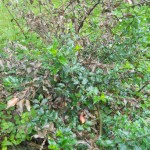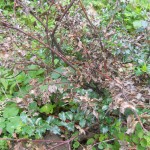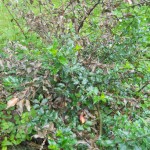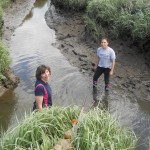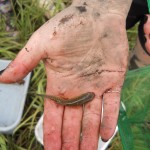In the middle of the winter, my American Holly, probably 6 years old, started to look sick. At least that’s what I thought. Almost overnight, at least half of the bush was brown. The leaves were shiny and brown, though, not dull and dry like I might have expected if they were dead. I couldn’t figure out what the problem was. I wondered if perhaps, they were just in some type of rotation, were they going to drop off and be replaced like the white pine needles do periodically? ? Why would only have the bush be rurning brown? Perhaps it was really a second Holly , rooted next to the first?
This mystery remained and I passed the bush each day, watching it turn browner and greener on one half and the other, as snow melted, grass grew, , and weeds becan to fill the hollow at its base. Overwhelmed by the spring grading, finals, and an early summer course, I let the mystery lie. One day however, i took a closer look. It is one tree. Half was indeed, looking dead. The branches from the two halves are intertwined, but all the green come from one base branch, and the brown from the others.
Further investigation suggests that i have a case of Botryosphaeria Canker, a type of fungus, although there is an off chance the problem actually started with a different fungus, invading through the roots. All of the fungi are worsened by a combination of drought (which we experienced last summer) and flooding, which we had experienced in the spring. So I guess just leaving the holly and figuring that it would all be fine as long as it didn’t die from the drought, probably wasn’t best. The holly was likely stressed and more susceptible to an infection.
So keep your plants healthy, and avoid all of this grief, I suspose is the take home lesson. I removed the dead parts, but cannot guarentee the fungus cannot spread to the living remaninder.

